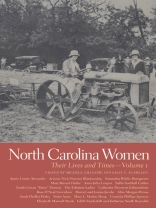North Carolina has had more than its share of accomplished, influential women—women who have expanded their sphere of influence or broken through barriers that had long defined and circumscribed their lives, women such as Elizabeth Maxwell Steele, the widow and tavern owner who supported the American Revolution; Harriet Jacobs, runaway slave, abolitionist, and author of Incidents in the Life of a Slave Girl; and Edith Vanderbilt and Katharine Smith Reynolds, elite women who promoted women’s equality. This collection of essays examines the lives and times of pathbreaking North Carolina women from the late eighteenth century into the early twentieth century, offering important new insights into the variety of North Carolina women’s experiences across time, place, race, and class, and conveys how women were able to expand their considerable influence during periods of political challenge and economic hardship, particularly over the course of the late nineteenth and early twentieth centuries.
These essays highlight North Carolina’s progressive streak and its positive impact on women’s education—for white and black alike— beginning in the antebellum period on through new opportunities that opened up in the late nineteenth and early twentieth centuries. They explore the ways industrialization drew large numbers of women into the paid labor force for the first time and what the implications of this tremendous transition were; they also examine the women who challenged traditional gender roles, as political leaders and labor organizers, as runaways, and as widows. The volume is especially attuned to differences in region within North Carolina, delineating women’s experiences in the eastern third of the state, the piedmont, and the western mountains.
عن المؤلف
SALLY G. Mc MILLEN is the Mary Reynolds Babcock Professor of History at Davidson College. She is the author of Motherhood in the Old South: Pregnancy, Childbirth, and Infant Rearing; Southern Women: Black and White in the Old South; To Raise Up the South: Sunday Schools in Black and White Churches, 1865–1915; and Seneca Falls and the Origins of the Women’s Rights Movement.












